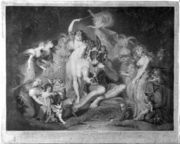The Taming of the Shrew (Engraving)
Artist/Maker: Robert Thew (1758-1802), engraver, after Robert Smirke (1752-1845)
Created: 1791
Origin/Purchase: England
Materials: stipple engraving
Dimensions: 43.8 × 59.7 (17 1/4 × 23 1/2 in.)
Location: South Square Room
Provenance: Thomas Jefferson; by purchase at the Dispersal Sale in 1827 to Colonel Alexander R. Holladay; by descent to William Holladay Worth; by loan to the Thomas Jefferson Foundation since 1965
Accession Number: 1965-47-2
Historical Notes: These two prints of scenes from William Shakespeare's A Midsummers-Night's Dream and The Taming of the Shrew are among the rare survivors from Jefferson's print collection, the only ones that have been located from the 1827 Dispersal Sale of his belongings. Jefferson was well acquainted with Shakespeare's works; he recommended them to his friends and gave them to his grandchildren.[1] "Read the best of the poets...," he advised a young friend, "But among these Shakespeare must be singled out by one who wishes to learn the full powers of the English language."[2] Jefferson owned anthologies of Shakespeare's plays, as well as a concordance and books of criticism. Though Jefferson asked John Trumbull to obtain a copy of Shakespeare's portrait for his collection, it seems that these prints were the only representation of the writer at Monticello.[3]
The engraving from A Midsummer-Night's Dream depicts Act IV, Scene I where Titania, Queen of the Fairies – who is enamored of Bottom because of the love portion she has taken – waits upon the donkey-headed man with her attendants. The scene shown from The Taming of the Shrew is the induction, Scene II, in which the tinker, Christopher Sly, is fooled into thinking he is a wealthy lord who has been asleep for many years. The attendants pose as courtiers and the page as his worried wife.
These two works were among 100 prints that were published by John and Josiah Boydell as part of their monumental Shakespeare Gallery project. Financed completely by the Boydells, the gallery operated from 1789 until 1803 and exhibited as many as 170 specially commissioned paintings of scenes from Shakespeare's plays, from which engravings were made. John Boydell attracted England's finest painters and engravers to his project, and the paintings by Robert Smirke and Henry Fuseli are considered to be masterpieces of their kind.[4]
-Text from Stein, Worlds, 183
Further Sources
- Open Source Shakespeare. "The Taming of the Shrew (1593)."
References
- ^ Jefferson to Robert Skipwith, August 3, 1771, in PTJ, 1:76-81, and Randall, Life, 3:346, 3:349. Transcription available at Founders Online.
- ^ Jefferson to John Minor, August 30, 1814, including Jefferson to Bernard Moore, [ca. 1773?], in PTJ:RS, 7:629. Transcription available at Founders Online.
- ^ Jefferson to Trumbull, January 18, 1789, in PTJ, 14:467-68. Transcription available at Founders Online.
- ^ A.E. Santaniello, ed., The Boydell Shakespeare Prints (New York: Benjamin Blom, Inc., 1968), 5-9; Winifred H. Friedman, Boydell's Shakespeare Gallery (New York: Garland Publishing, Inc., 1976), 2-18, 223, 238, 266.
